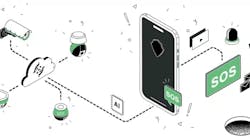The days of scratchy images recorded on videotape are long gone. Advances in surveillance camera technology mean crystal-clear digital pictures that can be viewed in real-time as events occur, or recorded for later viewing. So what are the benefits of proactively protecting businesses with live surveillance? Is there a benefit to using this type of surveillance over traditional recorded video? There is nothing new about how camera surveillance works — it is how to get the most out of the equipment that is up for discussion.
Deterring Crime
Real-time surveillance consists of live remote guarding protocols using an existing or augmented surveillance camera system. In many cases, the facility’s security guard team is tasked with this responsibility. But an Internet-enabled camera infrastructure allows the cameras to be viewed from a remote location. If business owners do not have the time to watch their cameras or do not want to hire security staff to watch them, there is the option of outsourcing this function to a remote surveillance company.
Live virtual guards watch as events unfold and they can act accordingly on an owner’s behalf — whether that means a call to the owner or to the police. With the use of security cameras and an IP infrastructure, property owners and first responders can watch what’s happening in real-time and this advancement in outsourcing is changing the way crime is prevented, reported and prosecuted.
Police say surveillance cameras, whether installed by businesses, homeowners or local governments, act as a powerful enforcement tool and crime deterrent. The reality for both police departments and business owners is that security staff cannot be everywhere at once. With live remote surveillance, the security staff has, in effect, an extra pair of eyes.
Live Surveillance for the LAPD
Using live surveillance and remote monitoring services from Iveda Solutions, the Los Angeles Police Department keeps tabs on a large parking lot at one of its facilities. According to LAPD Officer Alex Arredondo, when the Iveda intervention specialist on duty alerted them that a break-in and theft was taking place, Arredondo and his fellow officers were able to track the perpetrator using a live video feed. The technology and human interaction behind it not only helped them make the arrest, but also aided in the prosecution.
“We simply could not have caught this guy had it not been for the live cameras and the security technician directing us to where we needed to be,” Arrendondo said. “I think that technology like this is a great way to help police forces — by monitoring problem locations like narcotics spots, gang neighborhoods and even to alert officers of danger.”
Iveda specializes in IP video hosting and real-time remote surveillance services, using a combination of Internet-enabled cameras, a secure data center, and intervention specialists to monitor and respond to situations in real-time.
Live Surveillance for Business
For business owners, the most obvious benefits of this kind of service-driven technology translates into a major boost for their bottom line — due to a decreased need for security staff, as well as less internal and external theft, vandalism, etc.
Henry Valenzuela, manager of the East Bay branch of a national auto auction company, must secure a sprawling multi-acre parking lot. It was a major undertaking for any security solution and the logistics of covering it adequately proved to be too daunting a task for the existing staff. Several years ago, the company was dealing with crimes that included small-time vandals and vehicle break-ins. The reality was the facility was so large that there was simply no way for security staff to monitor it at all times.
Instead of more than doubling on-site security staff, Valenzuela instead decided to employ live remote surveillance services. This has since been expanded into several of the company’s other branches in the western region. “Since going this route, our branch alone has saved approximately 56 percent a month — not including the cost of a live security operation, which includes restroom rentals, theft damage, staff turnover, etc.,” said Valenzuela. “Customizing the monitoring schedule to fit the needs of our branch was simple, and it has identified activity that would have otherwise gone unnoticed or unprosecuted.”
Hudd Hassell, president of Bela Flora — part of a group of luxury custom real estate communities in Arizona — has also found live remote surveillance to be a cost-effective alternative to traditional security guard service or an in-house security staff. While simply using camera footage of a crime would possibly allow them to prosecute a trespasser, it would not give the added extra protection its residents currently enjoy.
“From the very beginning, we wanted to have a 24-hour guard-gated community, but we didn’t want to saddle the homeowner’s association with the traditional expenses associated with security of that caliber, — estimated at $120,000 per year in salaries,” Hassell said. “Even in a boutique subdivision like ours, at that rate you would break the bank pretty quickly or have to charge dues of $400 to 500 per month.”
For Farnsworth Realty and Management president Joe Farnsworth, theft and vandalism were once just a part of the landscape of managing real estate properties. Over time, those damages and losses added up, for both Farnsworth and his clients. For Farnsworth, the ability to access his cameras at any time, from any computer was what originally sold him on the idea of switching to live surveillance services.
“The convenience and peace of mind of being able to check on my properties from any Internet location is really helpful,” Farnsworth said. “As a business owner, especially with multiple locations across multiple states, there is so much on my plate. It is wonderful to be able to check this off of my to-do list.”
Using the power of the live images gives remote monitoring specialists, security guards and law enforcement personnel the ability to thwart crime while it is happening. From real estate management to auto auction companies to luxury gated communities, there are few businesses that do not have security concerns, so it is important to research the options and to find the solution that makes the most sense for specific needs and budgets.
Luz A. Berg is the senior vice president of operations and marketing for Iveda Solutions, a full-service IP surveillance company based in Mesa, Ariz. For information, visit www.ivedasolutions.com.
SIDEBAR1
Top Questions to Ask When Implementing a Live Remote Surveillance System or Service
Can I use my existing analog CCTV cameras?
Should I invest in good-quality network cameras?
Should my cameras be stationary or movable (PTZ – pan-tilt-zoom)?
Which cameras need to be watched or simply recorded? How many hours per day?
What kind of daily reporting or audit trail comes with the service?
How can I permanently keep archives of selected events?
Do I need 7 days, 14 days or more of recorded video at all times?
If choosing an online video hosting solution, what frame rate and resolution do I need? Is one frame per second adequate when I can see more of the event at 6 frames per second?
Do I need this video to protect against losses or false injury claims?
How do I want to access my cameras’ recorded video — via Internet, or DVR/NVR access, or from a PDA or cell phone?
Does my offsite surveillance team have the ability to call the police if something happens on my property?
Can multiple first responders (i.e. police or fire department) access my cameras at the same time without video degradation quality?
Does the service use a data center? If so, how secure is it?
Does my surveillance system allow for hosted video and real-time remote surveillance?
Is my system scalable? Does it allow for flexibility in the future?

